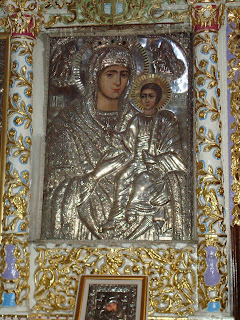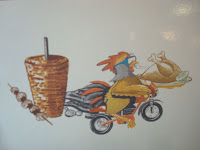
October 2009
October 29, 1923, the Turkish constitution was amended and Turkey became a republic. This formally declared the dissolution of the Ottoman Empire. Essentially it's "4th of July". Fireworks and parades mark the celebration and on every balcony the Turkish flag flies high. Schools were closed, so we took the opportunity to travel for the long weekend. Our Destination was to the Greek Island of Chios.
We went by bus to the sea town of Cesme, about an hour from Izmir and caught an afternoon ferry to Greece. It takes about 45 minutes to cross the Aegean to reach the island. We arrived in the evening as the sun set on the island and rented a car for the weekend. Five of us squeezed into a Renaut Clio and headed for the grocer. One of the first major differences in Greece is the alphabet. Not knowing the language is one thing but not recognizing text and sounds is quite odd. Here are a few different Greek letters that I can't pronounce- ΣΘΠΣΔΦΓΗΞΛΨΩ. Not to mention learning Turkish has conditioned my pronunciation of English letters. So the grocery store was quite an "egg hunt". Shopping lists in hand we stocked up on bacon, pork sausage, peanut butter and some booze, and had a blast looking at the labels and packaging, especially the candies and cereals. Now the fully loaded down Clio took us to our pension called Mouzaliko (http://www.mouzalikohotel.gr/). I'd recommend the place.

This was well worth it! A great family resturaunt with one guy running the place. Literally running with loaded dished up and down the stairs to the basement kitchen. In the states this would have taken 4 server minimum and this guy did it all, and did it well! We ended up eating mostly appetizers; cheese plate, teziki, Greek salad (of course), calamari, fresh bread and a few bottles of ouzo.

The next day we hit the road and traversed over the Southern part of the island. Along the roadside there are these "God mailboxes". We seem to notice they often occured at a windy curve. Looking inside you'll see alters with religious icons, trinkets and candles, and offering. They are beautiful inside with hammered silver reliefs of patron saints, mosaics, or fresco's. There are many along the road of all different miniature replicas of churches. Thankfully one did not have to be built for us on one of these narrow cliff roads.

Driving between towns is not far, but may take some time due to the mountain road and photo opportunities. As we headed towards Pyrgi, we ventured up the hill and stopped at the remote Monastary of Παναγία Σικιελιά. The impressive door was locked but the ancient key hole was big enough to get a generous peek of the beautiful interior.

The next town to divert our travels was Mesta, just to take a peek, look at the center bell tower and drive though the streets not made for automobile. We were then delighted to be squeezed in the small Renault. Anything bigger and we just wouldn't have fit.

We arrived in Mesta which still stands as it was built. The city is built for defense. Narrow passages, some leading to dead ends. Built behind fortified square design with a defense tower at its
center and only a few entrances with huge steel gates. No cars allowed here. Here we sat and had a fabulous lunch- Gyros- What else!


 Then we headed for Pyrgi. This is a town know for the decorative facades on every building with the unique black and white geometrical decor of the outer walls of the houses. -The "xysta"(scraped graffiti) -are the things which enchant the visitor. Again narrow roads, the innumerable churches, and amongst them the 13th century Byzantine church of St. Apostles. We loaded the camera with photos and enjoyed a snack in the town square.
Then we headed for Pyrgi. This is a town know for the decorative facades on every building with the unique black and white geometrical decor of the outer walls of the houses. -The "xysta"(scraped graffiti) -are the things which enchant the visitor. Again narrow roads, the innumerable churches, and amongst them the 13th century Byzantine church of St. Apostles. We loaded the camera with photos and enjoyed a snack in the town square.
The next day we headed north along the east coast Just north of Chios is Vrontados which lays claim as the birthplace of Homer. Its connection to the poet is supported by an archaeological site known traditionally as "Teacher's Rock" (Δασκαλóπετρα). So here is a few more teachers for Homers school house rock!
Then off to the fishing town of Λαγκάδα or Lagada. Here we sat as they pulled fresh octopus from drying racks to prepare for our lunch. We had octopus, calamari and fresh fish for lunch. This was a very popular with the local cats. We had about 9 under our table as we ate waiting for our hospitality. Very well fed and very polite. It started to rain so we decided to sit for another round talking with the locals. But, with more to see, we headed out to circle the north island for photo opportunities.
Then off to the fishing town of Λαγκάδα or Lagada. Here we sat as they pulled fresh octopus from drying racks to prepare for our lunch. We had octopus, calamari and fresh fish for lunch. This was a very popular with the local cats. We had about 9 under our table as we ate waiting for our hospitality. Very well fed and very polite. It started to rain so we decided to sit for another round talking with the locals. But, with more to see, we headed out to circle the north island for photo opportunities.


The Island is famous too for it's cultivation of mastic. An evergreen shrub or small the of the pistacio family which is harvested and hand processed for its aromic resin. Here you can get mastic soda, mastic gum, mastic taffy and even a liquor of mastic, and you'll see people sifting and preparing mastic just about everywhere you go. You'll have to try some.













No comments:
Post a Comment